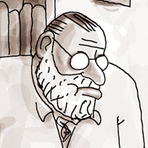Bigger Belly But Better
Belly fat is not good. It can increase the risk of many health issues, such as heart disease, diabetes, cancer, stroke, high blood pressure, sleep apnea, dementia, metabolic disorders, kidney problems and joint and back pain.
But it turns out that maybe not all belly fat is equally bad. Researchers studied belly fat from people who had a long history of exercising and people who didn't exercise at all. (The two groups matched in other ways, such as weight, sex and body fat mass.)
The belly fat in exercisers had more blood vessels, mitochondria and beneficial proteins, and less of a type of collagen that can interfere with metabolism. It also had fewer cells that cause inflammation.
Importantly, the belly fat examined was taken subcutaneously, from just under the skin, which appears to be the healthiest place for storing fat. Exercise increases the capacity to store fat there, rather than viscerally around internal organs or in the organs themselves.
Body of Knowledge
The blood vessels in the human body form an extensive network, measuring between 60,000 to 100,000 miles. If stretched out, these vessels would be long enough to circumnavigate the globe more than three times. It takes a red blood cell less than a minute to move from the heart through the body and back to the heart.
Get Me That, Stat!
All 50 states require vaccinations before entering child care or school. Forty-five states allow exemptions based on religious or personal beliefs or both. Five have no permitted vaccination exemptions: California, Connecticut, Maine, New York and West Virginia.
Doc Talk
Gossypiboma: An object accidentally left inside of a patient after surgery
Mania of the Week
Mythomania: A pathological tendency to lie, exaggerate or relate incredible imaginary adventures as if they had really happened; occurs in some mental disorders
Best Medicine
Exercise tip: Lifting dictionaries can add definition to your muscles.
Observation
"I'm allergic to food. Every time I eat, it breaks out into fat." -- Jennifer Green Duncan
Medical History
This week in 1981, aspartame artificial sweetener was approved for tabletop use by the U.S. Food and Drug Administration. Its permitted uses included candy, tablets, breakfast cereals, instant coffee and tea, gelatins, puddings, fillings, dairy-product toppings and as a flavor enhancer for chewing gum, among others.
The sweetener was inadvertently discovered during research on a potential ulcer drug. By weight it was about 200 times sweeter than sugar, with very few calories. G.D. Searle marketed it as NutraSweet.
Ig Nobel Apprised
The Ig Nobel Prizes celebrate achievements that make people laugh, then think. A look at real science that's hard to take seriously, and even harder to ignore.
In 2002, the Ig Nobel Prize in medicine went to Chris McManus of University College London for his well-balanced report "Scrotal Asymmetry in Man and in Ancient Sculpture."
Fit to Be Tried
There are thousands of exercises, and you've only got one body, but that doesn't mean you can't try them all. Most research suggests static stretching before exercise has no effect on -- and may actually hinder -- performance during strength and power training. But there is some new evidence that posits stretching to improve flexibility may help you live longer because people with the stiffest joints are more likely to die prematurely.
Here are three stretching and flexibility exercises you can do standing. Last week, we showed four exercises you can do sitting down.
1. Quadriceps Stretch
Purpose: Stretch quadriceps (front of thigh) and strengthen hamstring (back of thigh).
Starting Position: Stand with your left side to the wall, 12 to 18 inches from the wall. Place your left hand against the wall for balance, keeping that arm slightly bent.
Action: Raise your right heel toward your buttocks. Reach back with your right hand and grab your foot at the heel, ankle or sock. If you can't reach your foot, grab your pant leg or just raise your foot as high as you can and still feel comfortable. Hold for 10 to 30 seconds. Be sure you're standing tall and looking straight ahead. Your knee should be pointing toward the floor, and your ankle should be in a straight line with your leg, not twisted to the side. Let go of your foot and slowly return to starting position. Then repeat. Complete one set, then turn around and hold the wall with your right hand when working your left leg.
Repeat: One to three times with each foot. Rest, then do a second set.
2. Hamstring Stretch
Purpose: Stretch hamstring (back of thigh).
Starting Position: Stand with your left side to the wall, 12 to 18 inches from the wall. Place your left hand against the wall for balance, keeping that arm slightly bent.
Action: Place your left heel on the floor in front of you. Lean forward from your hip (not your waist). Push your hip back and reach toward your toe with your right hand. Your foot can be pointing up (as shown) or flat on the floor, whichever is more comfortable for you. Make sure to keep your shoulders and back straight as you reach forward. Hold for 10 to 30 seconds. Return to starting position. Then repeat. Complete one set, then turn around and work the other leg.
Repeat: Three to five times with each leg. Rest, then do a second set.
3. Calf Stretch
Purpose: Stretch the calf (lower part of the back of the leg).
Starting Position: Stand facing a wall slightly farther than arm's length away, feet shoulder-width apart. Lean against the wall, with both hands on the wall.
Action: Bend one leg, and place the foot on the ground in front of you. The other leg extends behind you with the knee slightly bent. Both feet point straight ahead. Slowly move your hips forward, keeping your lower back flat. Be sure the heel of your back foot is flat on the floor and your weight is on your back heel. Hold for 10 to 30 seconds. Then return to starting position. Repeat with other leg. Continue alternating legs.
Repeat: One to three times with each leg. Rest, then do a second set.
Sum Body
Three facts about human teeth:
1. One in 2,000 babies is born with natal teeth, which usually grow on the bottom gums and tend to have weak roots. They're often removed to prevent problems with breastfeeding and accidental swallowing.
2. By age 3, the average child has a full set of 20 "baby teeth," which will eventually be pushed out by 28-32 adult teeth. But not always. When a person doesn't have an emerging adult tooth, the baby tooth will stay put.
3. Tumors can grow teeth. So-called teratomas are rare germ cell tumors containing several types of tissues and are usually found in the ovaries, testes and near the tailbone. They may contain teeth, hair, eyes or bones. Usually, they are benign and can be surgically removed.
Curtain Calls
In 2018, a spelunker named John Edward Jones attempted to crawl through an unmapped passage of the Nutty Putty Cave in Utah. Jones was 6-foot and weighed 200 pounds. The passage was no wider than the opening of a washing machine.
Jones soon found himself stuck, face down, his arms pinned below and behind him. Rescuers reached Jones' feet, but they could not extricate him despite hours of frantic effort, including pouring down vegetable oil as a lubricant and trying to chip the passage wider.
After more than two days trapped, Jones died from exposure. Efforts to retrieve his body were deemed too difficult and dangerous. The passageway and cave were permanently sealed, entombing and memorializing Jones.
========
To find out more about Scott LaFee and read features by other Creators Syndicate writers and cartoonists, visit the Creators Syndicate website at www.creators.com.
Copyright 2024 Creators Syndicate Inc.









Comments